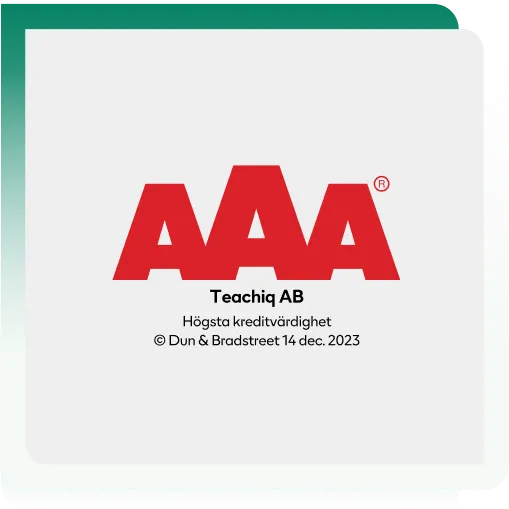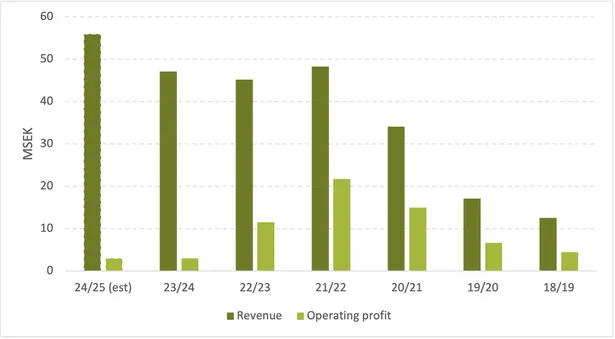Economic stability
Teachiq AB was founded in 2015. From the very beginning, maintaining a healthy and sustainable financial foundation has been a core priority. We have not relied on venture capital, nor have we been forced into abrupt strategic shifts—whether through aggressive spending or sudden cutbacks.
Below, we provide a commentary on our financial position. The purpose is to offer transparency to potential customers and partners, so they can feel confident in Teachiq’s financial resilience and long-term stability. Teachiq’s fiscal year is aligned with the academic calendar and therefore runs from July to June.


Estimate for fiscal year 24/25 and outcomes for previous years.

Financial Commentary – Fiscal Year 24/25
The previous year was an investment year, and this has continued to shape the current fiscal period. Several ongoing investments have extended into 2024/2025, holding back profitability in the short term, while we are once again seeing clear revenue growth.
Key developments framing the year include:
- Continued investment in the KM technical platform and supporting systems. The new version of KM is on track to be rolled out during the 2025/2026 school year. Our system upgrades are already delivering significant gains in how we support and develop our customers efficiently.
- Exam.net continues to grow strongly outside Sweden. A high number of new schools are entering evaluation periods, and conversion rates remain high with exceptionally low churn - a testament to customer satisfaction.
- Multiple teams have been reinforced to meet growing demand and seize the opportunities ahead. Product development, support, and content teams all grew during the year. While these reinforcements have temporarily flattened operating profit, they support the continued growth in revenue and are expected to drive profitability improvements in 2025/2026.
A significant organizational change this year was the transition of CEO. Anders Torkelsson, who co-founded Teachiq with Erik Corell in 2015, stepped down after ten years in the role. As of January 1, 2025, Marie Cederholm (previously CFO) has taken over as CEO. Anders and Erik continue to be actively involved as working board members.
Financial Commentary – Fiscal Year 23/24
The 23/24 fiscal year was, in many respects, another investment year:
- We made significant investments in the technical foundation of Kunskapsmatrisen (KM), a long-term project designed to unlock new features and workflows requested by our users.
- Nearly all teams were expanded - including support, product, sales, marketing, and customer success - driven by increased usage and a forward-looking belief in our growth potential.
- We heavily invested in our internal systems to gain flexibility and maintain high service levels across all products.
These strategic investments temporarily suppressed operating profit, despite a return to revenue growth. Our user base of teachers and students has expanded significantly, but this is not yet fully reflected in our revenue. Where appropriate, we are adjusting our pricing to reflect this increased usage - for instance, by phasing out the discounted pricing for lower-secondary schools using KM in Sweden, as the product is now well-developed and established for that segment. In summary, this was an investment year that has impacted short-term profitability but reinforced long-term financial stability and product strength ahead of coming school years.
Sammantaget är vi alltså i ett investeringsår som pressar lönsamheten men som fortsatt säkrar en ekonomisk stabilitetet - och som stärker oss och produkterna inför kommande läsår.
Financial Commentary – Fiscal Year 22/23
We continued to invest in product development, strengthening our teams in engineering, design, and product management. Key improvements, such as deeper integration with Google Classroom, reached our users during the year. We also ramped up our marketing and sales efforts, especially internationally.
Major steps were taken toward the next generation of Kunskapsmatrisen (KM). A notable milestone was the launch of our new exam creation tool, which enabled us to begin testing math content for non-Swedish markets under the new “Exam.net Maths” brand toward the end of the year.
Financial Commentary – Fiscal Year 21/22
Exam.net continued to benefit from school closures during the COVID-19 pandemic, with international demand translating fully into revenue during this year. We adapted our organization accordingly, strengthening several core functions.
Our investment in user experience and content for KM, initiated the previous year, was expanded further. We also launched a major project to develop a new technical platform for KM, to be ready by the 2024/2025 school year.
In short, while cost and revenue levels during this fiscal year are not representative of a long-term equilibrium, our positive financial results enabled us to pursue ambitious product investments.
Financial Commentary – Fiscal Year 20/21
This year marked the beginning of several major initiatives for KM, focused on both content and user experience. We hired additional educators to produce and quality-assure content and deepened the engagement with existing teacher contributors. A large-scale development project was also launched to enhance the user experience and introduce long-requested functionality - with the main benefits expected to become visible during 2022/2023.
For Exam.net, international growth was the dominant theme. A surge in demand from outside Sweden, driven by pandemic-related school closures, continued throughout the year. We adjusted our product and organizational structure to meet this expanded demand, including the establishment of a U.S. subsidiary with a local hire. By year-end, we transitioned from offering Exam.net for free outside Sweden to implementing a paid model, significantly boosting second-half revenues.